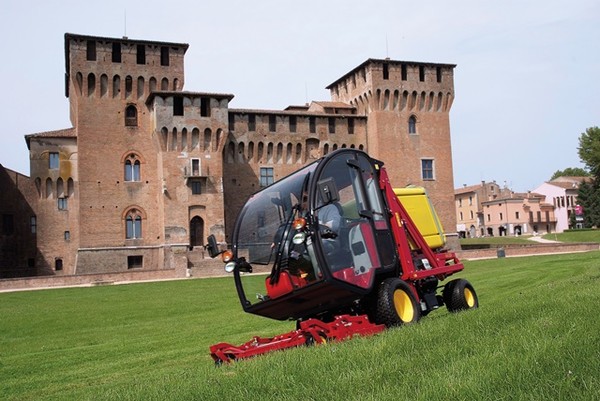
Gardening: machinery and equipment for all types of greenery
Taking care of green areas requires a wide range of machinery and equipment built for a public of professional groundskeepers as well as hobby enthusiasts. Choosing mechanical means must be made on the basis of the size and characteristics of the green area to maintain and in relation to the architectonic models on which to base the design and management of gardens
Garden equipment is obviously associated with the numerous types of garden. Stated simply, the range is from English gardens to the Italian type. The former are characterized by a closer approach to the natural environment with ample lawn areas, trees and shrubs organized in a way which reflects a natural landscape and possibly also flanked by such artificial features as grottoes, foot bridges and the like. Italian, or formal, gardens on the other hand have their origins in the Renaissance with areas laid out according to planning which involve geometrics, divided up through the use of rows and hedges, vegetation sculpted into various shapes and trees and other plants arranged in a way which leaves nothing to chance.
Then there are various types of Mediterranean gardens, French and Japanese gardens. Roof gardens, garden squares and hanging gardens have been developed in more recent times. The first two are built on the top of an architectonic structure or in an urban square for scenographic purposes and to improve the microclimate on the building or surrounding buildings and the later is grown on the walls of buildings to beautify the urban scene and reduce air pollution, especially PM-10 particulate matter. It must also be pointed out that in 1950 only 29% of the world's populations lived in cities whereas by 2009 this percentage had climbed to 51% and today urban populations have reached 3.5 billion people. Cities are paved and urban motor vehicle traffic has grown to worsen the quality of urban life. Greenery in general and gardens in particular are instruments capable of reducing the results of the paved environment to improve the quality of life.
Especially abroad, and in Italy as well, the idea that greenery helps generate better health is making progress and the most ambitious expression of this concept are in healing gardens or therapeutic gardens which are genuine rehabilitation facilities. Thus there is an awareness that greenery and gardening work help people who are ill or handicapped in ways which limit their activities.
Alongside the various types more or less well defined there are many private gardens which do not fit into predetermined schemes but spring from singular initiatives and personal choices. However also these share the need for care and maintenance.
Following is a study of some of the basic equipment used in gardening.
Preparation of the soil and seeding
Manual equipment or power tools are used for preparing the ground for seeding, for example, a lawn. The spade is the main item among manual tools and spading is followed by more manual work with the use of the hoe and rake for pulverizing the soil. The labor involved in spading the ground can be lessened by the use of the so-called technological spade equipped with a system which reduces the physical effort needed.
Among the items of powered equipment are tillers and cultivators put to use on surfaces which are not elevated for DIY gardening, like the case above. The most recent models of these machines are electric and the highest performance types reach 20 kW power.
Tillers are capable only of breaking up the ground and are smaller than cultivators. These are more versatile because they can be equipped with PTOs for mounting a variety of implements, from a cutter on the mower bar to seeders and fertilizer spreaders. Moreover, they can also tow small plowshares for plowing the surface of the terrain. Multifunctional equipment built on the basis of brush cutters make it possible to hoe down to various depths and well as perform mechanical weeding and pulverize the soil thanks to the various blades which can be mounted.
Large areas are prepared with the deployment of plows, cutters and spaders mounted on tractors.
Seeding small areas can be done by hand by distributing the seeds twice, up and down and back and forth. Quantities are determined by the size of the seeds. In the grass family, such as festuca or ryegrass, the quantity is 25-40 g/m2. The process is completed by raking and watering performed with a traditional watering can or sprinkler irrigation. Seeding big areas is done with the use of mechanical or pneumatic seed drills and also this procedure is performed with the two criss-cross passages.
Lawn maintenance
The most frequent operations carried out on lawns is mowing the grass. Brush cutters fitted with a nylon flail carried by the operator can be used for mowing small lawns and slopes. Electric mowers powered off a cord or batteries provide the advantages of light weight and low noise levels. Those run by internal combustion engines are more powerful and can be used in more demanding condition.
For maintaining lawns with a mower the ranges of these machines are enormous and selection depends basically on the quality of mowing and the size of the lawn area. For ornamental and quality lawns mowers with helical blade cutting mechanisms are preferred; otherwise the choice would be for one with a horizontal blade.
The size of the lawn conditions the type of traction selected, that is, a push mower or a ride-on model. The first type, for lawns of less than 1,500 m2, can be electric run off a cord or batteries powered at less than 2 kW or with an internal combustion engine at 5 kW. Ride-on mowers powered at 10-15 kW up to 40-50 kW make it possible to handle lawn areas greater than 1,500 m2. The motor conditions the mower's work capability.
Finishing operations, generally performed on high-quality lawns, can be done manually with grass scissors, electric or battery powered edging shears with oscillating sawtooth blades or even with verge trimmers with a vertical rotating blade.
Other maintenance operations which must be performed with a certain degree of frequency are defelting, for breaking up superficial deposits of organic materials done with equipment which makes a vertical cut in the lawn, and aeration of the soil, done with a subsoiler machine which makes deep cuts or with drilling machines or core drills. Also the selection of these machines depends on the size of the lawn. They range from models run by small electric motors or gasoline engines up to those mounted on tractors or are self-propelled.
The maintenance of trees, shrubs and bushes
Garden scissors and shears are available in a very diversified number of models. The traditional tools are made for cutting branches of bushes and brush to eliminate those in excess and especially to give greenery precise shapes to the point of creating a topiary by the training of live perennial plants. The defining characteristics of these tools are their sharp blades and the handles and grips lengthened for use with two hands.
There are special brush cutters with lengthened handles and ergonomic grips for manually trimming twigs and branches. There are versions for work on hard wood equipped with robust grooved blades which allow the plant lymph to run out the tips to avoid clogging the blade and other versions for cutting thick and thin branches. Another diversified category is that of pruning equipment equipped with telescopic extensions making it possible to prune branches of up to a certain height from the ground. To reduce the work of the operator there are branch shears which weigh only 1-2 kg with 1 kW electric motors and equipped with extensions for cutting branches with diameters of up to 4-5 cm.
Various models of hand saws, from bow saws to curved handled garden saws can also be used for the manual cutting of branches as well as telescopic saws equipped with vertical blades for shortening higher branches. Then too, garden shears with grips for use with one hand come in a great variety for cutting the branches and twigs with small dimensions.
For hedges over a certain length and plying the topiary art the market provides a wide selection of hedge trimmers. Internal combustion engine models range in length from 40 cm powered at 0.6-0.7 kW, to lengths of 75-80 cm powered at 0.7-0.8 kW. Their weight varies from 4 to 5.5 kg. Corded electric models feature power at 400-650 W and weight below 4 kg. Silent battery-powered hedge trimmers, without the inconvenience of the cord, are becoming increasing popular.
A significant number of trees in the garden means it will be necessary to add a chainsaw to the gardening equipment and there are numerous models with internal combustion engines or powered by electric motors run off the mains or batteries.
The diffusion of battery powered equipment
The market features increasing numbers of electric equipment items powered by batteries which reduce noise levels, vibrations and especially lower CO2 emissions into the atmosphere. Lithium ion and ion-polymer, at charge being equal, weigh one-quarter that of nickel cadmium. They are offered in a wide range of models with 3-4 Ah (ampere hours) to more than 20 Ah. The most widespread solution for these versions is backpack models but there are also those which can be strapped around the waist of the operator. To lower total direct CO2 emissions, those issued in use, and indirect emissions, those resulting from gasoline burned and electricity used, it need only be pointed out that for equipment such as hedge trimmers and brush cutters with power at about 1-1.2 kW equivalent, CO2 emissions come to around 3.5-4.5 kg/h from an internal combustion engine compared to emissions of less than 50 g/h by an electric motor.








